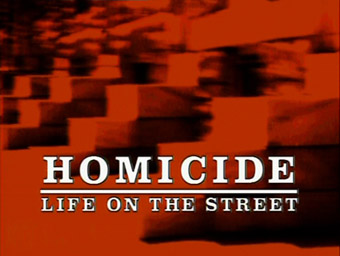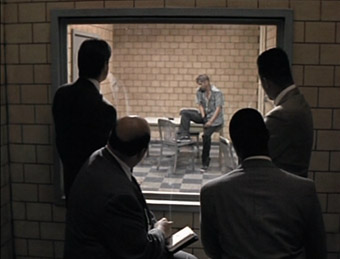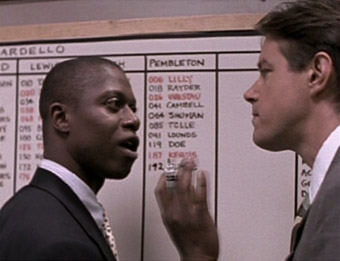|
Part
1: A First Series Overview
Or maybe that heading should read THE first series. Yes, for this
particular reviewer, Homicide: Life on the Street
was, and probably always will be, THE American TV cop show.
But I'm getting ahead of myself.
There's
something wonderfully perverse about the chance manner in which I first discovered Homicide. I was and remain a big fan of
Star Trek: The Next Generation – hell,
we all are here – and as a science fiction and horror film
devotee I used to subscribe to Cinefantastique, whose regular
season reviews of Star Trek were something
of an annual highlight. Their October 1993 issue contained
an episode guide for the sixth season by Trek expert Mark
A. Altman, the introduction to which included the following
intriguing statement:
"Along
with Homicide: Life On The Street, Star
Trek is the best one hour drama on television
today."
Now
at this point in time TNG was hitting television
high notes with impressive consistency, the best episodes
featuring some of the most accomplished writing and direction
on American or British television of the day. Cinefantastique,
meanwhile, was a crucial critical voice of the genre, and when
it spoke, fans took notice, and when it started talking
about a series – a non-science fiction series at that – being
as good as TNG, only a fool would not be
at the very least curious.

It
took a while for Homicide to appear on
UK TV and it did so without fanfare or much in the way of
press coverage. Another American cop show lands on British
television, and on a then minority channel at that. Now I'll freely
admit that my first encounter with the show left me fascinated
but not quite as hooked as I would soon become. The very
things that in retrospect make the first episode so extraordinary
seemed like small barriers to engagement on that initial
viewing, a shift of approach to a generic formula that required
a considerable adjustment on the part of the viewer. If
this happens to you then my advice is to stick with it, and if by some chance
you haven't made that adjustment by the end of the first
episode, then I can almost guarantee you will have by the
third, as by then you will better know the characters and
will have tuned in to the show's distinctive approach and
style. But approach that first episode with your expectations
wide open and you'll very quickly appreciate just how innovative
and compelling and beautifully written and constructed Homicide:
Life on the Street is.
It's
important to acknowledge that this is still a police prodedural
drama operating within rather than outside of the genre
and that many of its composite elements are TV drama and
cop show standards. The detectives in the Baltimore Homicide
Unit, for example, are an unsurprisingly diverse bunch,
with team loyalties and friendships regularly tested by
personal and professional conflict. They even have
an authoritative black captain, an almost staple requirement
of cop shows and films in the 80s and 90s. So what, exactly,
is so different about this series? Oh, where to begin...?
The
primary task of the opening episodes of any new series is to
introduce us to the characters with whom we will be spending the subsequent weeks. A favourite method of doing this is
through the arrival in the group of a newcomer to represent
the audience viewpoint, as their introduction to the location, the characters and the rules of this particular game
coincide with our own. Our sympathies are expected
to lie with them, and their take on this new world is one
we will ideally share. As they meet, learn from and engage with their new colleagues, then
so should we. The opening episode of Homicide,
titled Gone for Goode, certainly follows this formula,
but disrupts it in significant ways.
With that in mind, the most striking aspect of this first episode is that it
doesn't play like a first episode at all. Compare, for example,
Gone for Goode with Encounter at Far Point,
the pilot episode of Star Trek: the Next Generation,
and the differences become clear. For all its many merits,
Encounter at Far Point is unmistakably a pilot
episode. The actors are still finding their way into their
characters and Captain Picard's wonder at his new command
is used to introduce us to the starship and its crew. We learn that Troi is a half-Betazoid telepath,
that she and Commander Riker once had a thing going, that
Riker is a self-assured and skilled pilot, that Picard doesn't
like kids and has a history with the ship's doctor, Beverly
Crusher, that Data is an android armed with a childlike
curiosity and considerable strength, and so on. None of
this is absorbed organically – in almost every case the
narrative is effectively put on pause to introduce each of
these characters and their defining traits. Stand Encounter
at Far Point beside any later TNG
episode, where knowledge of all this is assumed, and the
differences in structure stand out a mile.
But
compare Gone for Goode with any other episode in
series 1 of Homicide and you'll be pushed
to spot any significant difference. The episode opens, as do a fair
few others, at a crime scene in the middle of a conversation
between two of the detectives, and if you're coming to the series fresh it will be a couple of minutes before
you realise that they are homicide detectives.
We're past the main title before new team member Tim Bayliss
(Kyle Secor) arrives on the scene. But against expectations he is formally introduced
to almost no-one and, like us, catches the other detectives
only in passing as they all but ignore him and go about
their business. All of them are already involved in cases,
the details of which emerge during the course
of the episode, and we work out who is who by eavesdropping
on their conversations. Like Bayliss, we walk into a squad
room whose inhabitants have known each other for some time
and whose loyalties and conflicts are already well established.
Like him we are outsiders in their company and will have
to learn about them as we go.

But there's more. Despite being set up here as the audience identification
figure, Bayliss turns out not to be our man. At least not yet.
His uncertainty and perhaps naive enthusiasm and the fact
that he pulled some strings at his previous post with
the Mayor's security detail to get this job prompt us to see him not through sympathetic eyes
but those of the unit regulars, as a newbie who is unlikely
to cut it in this department. This puts us in
the unusual position of being outsiders in a unit that we quickly engage with, or perhaps I should say want to
engage with. Like Bayliss, we desire to be accepted into
this group, but somehow believe we'd be more savvy and less
awkward than him in doing so.
This
break from the norm is further emphasised when, instead
of following Bayliss on his first day on the job, he is
paired off with one of the detectives and temporarily drops out of the narrative. We are left instead to ride with the
various partnered pairs as they go about their individual
investigations, intermittently catching up with Bayliss almost in passing.
It's here that we get to know the characters, as we hang
out with them and listen to them riff on everything from
relationships to old cases, from food to conspiracy theories.
The investigations themselves form only a small part of
this banter – like Pulp Fiction, the emphasis is on what the characters talk about between
the business of their jobs, and as with Tarantino's film, it's offbeat and engaging
stuff. That we connect with all of the detectives as screen
characters so quickly is down to a blend of creative writing,
interesting people who make believable detectives, and a
cast who have clearly nailed their parts before a single
frame of film was shot. In a complete reverse of the expected
norm, the character we've bonded with the least by the end of
the episode is newcomer Tim Bayliss.
First
developed by writer Paul Attanasio and steered to the screen
by executive producers Barry Levinson and Tom Fontana, the
series was inspired by and directly based on the superb
novel Homicide: A Year on the Killing Streets by
David Simon, a Baltimore Sun reporter who spent a year with
the city's homicide unit, whose cases and characters during
that period he chronicled in compelling detail.
Many of the real-life detectives and cases from Simon's book
are instantly recognisable on screen (Simon was creative
consultant to the series), and it is this reality base that
gives the series its strong sense of what it's actually
like to be a city homicide detective. As a result, we have
a clear feel for each of the characters by the end of the
first episode and by the close of episode 3 they are becoming like
old friends. It's no wonder that series fans became so involved
in their fate.
Lieutenant
Al Giardello, played by the marvellous Yaphet Kotto (whose
many big screen roles have included the Caribbean bad guy
Mr. Big in Live and Let Die and the obstinate
engineer Parker in Alien), is a typical
black police captain in first appearances only. Given to
referring to his Sicilian ancestry, he can be at his most
persuasive when smiling widely and offering deceptively
friendly advice, usually delivered as if he has something
incriminating on the detective he is addressing, and when he
does lose his rag you'd better be ready to run. Clark Johnson
plays Meldrick Lewis, a pragmatic city boy who
is initially caught indulging in a little casual racism
towards his long-standing partner, Italian-American Steve Crosetti* (played by John Polito, a veteran of over 150 film and TV
roles and particularly memorable for his roles in the Coen
Brothers' Miller's Crossing, Barton
Fink and The Big Lebowski), whose
unrelenting obsession with who really shot Abraham
Lincoln is driving Lewis to distraction. The squad's only
female detective, Kay Howard (Melissa Leo), dresses like
the guys for practicality and blends a dogged enthusiasm
with weary cynicism ("Homicide?" she responds
to Bayliss's enquiry, "We work for God"), which
may be at least partly due to her long-term partner Beau
Felton, a cop whose instincts are sometimes better than
his enthusiasm and who, as played by Daniel Baldwin, has
the genuine look of a put-upon scruff rather than the carefully
sculpted designer nerdiness you'll find in shows such as 24.
Detective John Munch, delightfully played by ex-stand up
comic and conspiracy theorist Richard Belzer, is unquestionably
one of the squad's most intriguing characters. A world-weary
cynic given to extensive philosophising and theoretical
musings, he tends to look back at the 1960s as a better
time, has continual relationship problems, and expresse
a liberal attitude to the whole issue of drugs. He
is partnered with tetchy, middle-aged divorcee Stan Bolander
(played by veteran actor Ned Beatty), who appears to tolerate
rather than actually respect Munch, whom he often unfavourably
compares to his old partner Mitch.

And
then there's Frank Pembleton. If ever there was a part that
the excellent Andre Braugher
(whose breakthrough film role was as the naive Thomas Searles
in Glory) was born to play, then the self-assured, fiercely intelligent
but sometimes infuriatingly stubborn loner Detective Frank
Pembleton is it. Braugher makes every moment register, whether
it be a casual, off-the-cuff "Yeah, leave the rookie
with me" that first teams him with Bayliss, or the
way he bemuses a suspect into signing away
his rights, or his explosive reaction to Bayliss's questioning
of his method of interrogation. It's only appropriate that
Pembleton is discussed before he is seen, the subject of
bar-room talk by the other detectives, imbuing him with almost
mythical status that is quickly shattered when, teamed with
the sarcastic Felton (who has little time for Pembleton's
sense of superiority), he forgets the number of the squad
car he has been assigned and methodically tries they key in every vehicle
rather than go back upstairs and admit his failing.
It's through Pembleton that the beauty of the show's writing
is most immediately evident. Consider the moment just before
we first enter The Box, squad slang for the soundproof room
in which suspects are interrogated. Bayliss asks to accompany
Pembleton to observe his working method, and where a lesser
series would have simply moved on to the interview itself
with an offhand "Just remember, this is my case, so
watch and learn" or similar, we get this:
"Then
what you will be privileged to witness will not be an
interrogation, but an act of salesmanship, as silver tongued
and thieving as ever moved used cars, Florida swampland
or bibles. But what I am selling is a long prison term,
to a client that has no genuine use for the product."
Sublime,
but so, so right for the character of Frank Pembleton, a
man for whom language is as much part of his professional
identity as his gun or badge. That said, Braugher is no
scene stealer – he works in perfect partnership with the
other actors and is an integral part of one of the best
ensemble casts the small screen has ever seen.
There's
no doubt that the series owes a huge dept to Stephen Bochco's
pioneering Hill Street Blues, whose multi-character
approach and rough-edged camerawork transformed the look
and feel of American TV police drama. Levinson and Fontana
build on Bocho's approach and further enhance the show's
documentary feel through the then unusual decision to shoot
on high speed Super-16mm stock (35mm was the still
format of choice for prestige productions in the US) and entirely hand-held, another American TV drama first.
Their masterstroke here was not to just try and emulate
the documentary look, but to hire documentary director and
cameraman Wayne Ewing (Free
Lisl, Benched:
The Corporate Takeover of the Judiciary, The
Last Campaign) as director of photography.
Ewing's contribution is crucial to Homicide's
still-unique look and feel – the post-NYPD Blue
twitchy camera technique that has become an almost obligatory
component of film and television dramas has no place here,
where the camerawork is as tight and fluid as it would be on a straight
documentary. It adds an urgency and immediacy to dramatic
scenes in a way that involves the audience as participants in the
drama rather than as cinematically distanced observers (car
conversations, for example, are shot from the back seat
rather than with the standard bolt-on camera mounts, placing
us in the position of passengers in the police vehicle).
The editing is similarly edgy, with the use of jump cuts,
repeated shots and a total disregard for the 180 degree
rule kicking sharply against the established technical standards of
television drama, but used to far better effect than the
MTV-inspired, look-at-me cutting of so much recent televisual
eye candy.
One
of the reasons TV's best cop show remained so compelling,
despite the almost complete absence of many of the expected
genre trappings (car chases and shoot-outs are rare and
we arrive at most murders only after the event), is that
the show gets under the skin of its characters, to the degree
that even straightforward seeming cases become as important to us as they do to the detectives. But in the end there
is no one thing that defines why Homicide: Life
on the Street is such bloody marvellous television,
but an almost divine combination of perfectly realised elements. In the finest episodes – and you'll
see a few of them in the first series – Homicide
is TV drama at its absolute best.
The
influence of the series on future police procedurals is
incalculable, its shadow visible on any number of other
films and TV series that followed in its wake. An impressive
array of respected filmmakers came in just to direct two or
three episodes, including actor-director Keith Gordon (The
Chocolate War), Barbara Kopple (Harlan
County, U.S.A.), Peter Medak (The Ruling Class), Uli Edel (Last Exit to Brooklyn), John McNaughton (Henry,
Portrait of a Serial Killer), Tim Hunter (River's
Edge), Katherine Bigelow (Near Dark,
Strange Days, Point Break), Whit Stillman (Metropolitan), Michael Lehmann (Heathers)
and Martin Campbell (Edge of Darkness),
and Dogme 95 maestro Lars von Trier has quoted it as a major
influence on the style of Dancer
in the Dark. Nothing, and I do mean nothing,
has come close to matching it, and it remains, for me, quite
simply the finest police procedural series American television has ever
produced.
And
yet it so nearly ended after just one season. With viewing
figures lower than expected, the network were all set to
cancel the future episodes when the unexpected happened
and it bagged two major Emmy Awards and was suddenly elevated
to the status of flagship show. There is little doubt that this
hiccup accounts for the oddity a second series consisting
of just four episodes.
The
A&E US DVD release retained the original series numbering,
but Fremantle's UK release combines series 1 and 2 into
one. If future series are also to be released in the UK,
fans should be aware that the series numbering will be out
by one. The episode guide that follows uses the original
production codes and A&E's episode and series numbering
for its order.
Page
2: Series 1 Episode Guide >>
|